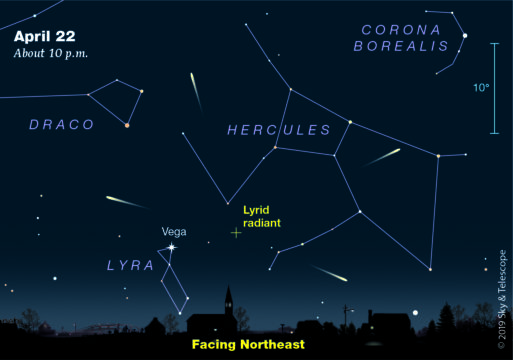The Moon gets in the way of April's Lyrid meteor shower, but it's still worth scanning the sky for the chance of fireballs.
The Lyrid meteor shower is predicted to peak on the night of April 21–22. Unfortunately, that’s not long after April 19th’s full Moon, which means the view will be compromised by moonlight. Even so, it’s worth scanning the skies for meteors. The Lyrids aren’t generally known for high meteor counts, usually numbering some 10–20 per hour, but fireballs have been reported in the past. And there have been a few times, most notably in 1922 in Poland and 1982 in North America, when the shower produced hundreds of meteors per hour. For observers in the Northern Hemisphere, the radiant, on the border between Hercules and Lyra, is low on the northeastern horizon at dusk and continues to rise throughout the night.

Follow the Shower Online
Have a spare hour? Grab a watch, clipboard, paper, and pencil and head outdoors. Track your meteor sightings and report them to the International Meteor Organization (IMO). Keep a tally for at least an hour, and try to determine if the meteors you've counted belong to the shower or if they're unassociated sporadics. See the IMO Visual Observations page for more information about counting meteors and recording your data. As meteor observers report their counts to the IMO, you can watch this year’s Lyrid activity curve develop hour by hour.
Coming Up...
Strong moonlight interferes with a lot of meteor showers this year, but Sky & Telescope predicts that one of the best meteor showers of the year will be the Eta Aquarids, coming up in the early morning hours of May 6th. Read more about the best meteor showers in 2019 and happy hunting!
A modified version of this article first appeared in the April 2019 issue of Sky & Telescope.
 1
1
Comments
Rod
April 23, 2019 at 7:55 am
FYI. It was great viewing last night before waning gibbous moon rise. Last night (before waning gibbous moonrise near 2329 EDT for my location) I enjoyed views of galaxy M87 in Virgo (where the EHT network telescopes imaged the black hole), M13 globular cluster in Hercules, and M53 globular cluster in Coma Berenices. The Lyrid peak was past but the Lyrid radiant was up shortly before 2100 EDT. I did see one meteor about +2 magnitude streak through Coma Berenices and Ursa Major. Some polar orbiting satellites were also on display moving through Draco and Ursa Major. Perhaps I observed a late Lyrid meteor last night.
You must be logged in to post a comment.
You must be logged in to post a comment.